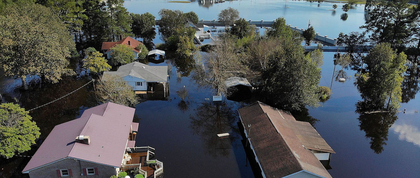
Short and Long-term Effects of Disasters: Hurricane Florence and More
By: Alexis Merdjanoff, Rachael Piltch-Loeb, David Abramson
The devastation caused by Hurricane Florence has once again brought natural disasters to the forefront of national news. Multiple casualties, ongoing flooding, over a million homes without power, and the loss of domestic and commercial property -- the effects of Hurricane Florence will have immediate impacts as well as long-term, cascading consequences. In addition to economic and infrastructure damage, disasters have enduring impacts on the health and well-being of exposed populations. Exposure to a disaster is among the most complex contributors to poor mental and physical health that individuals and communities may face.
Currently, there’s a debate in the political sphere about how to accurately define and measure the true consequences of disasters. Shortly before Hurricane Florence’s landfall, researchers from the Milken Institute School of Public Health at the George Washington University published an independent report (full results can be found here) commissioned by the Government of Puerto Rico, estimating that there were 2,975 excess deaths from Hurricane Maria between September 2017 and February 2018 (when the study was conducted), and that the greatest effects were for people of lower socioeconomic status.
The President was quick to criticize these estimates as an effort by Democrats “to make him look as bad as possible.” In doing so, he questioned the timeframe by which mortality can be attributed to a disaster. Brock Long, who serves as director of the Federal Emergency Management Agency (FEMA), was similarly skeptical. He stated that the excess death numbers “are all over the place” and that he “didn’t know why the studies were done.”
As Scott Knowles wrote in a New York Times opinion piece, these comments present a narrow and limited definition of disaster impacts. As Knowles put it, “[This] disaster logic tells us that firefighters who are now sick after responding to the World Trade Center after the Sept. 11 attacks are not victims, and that soldiers suffering PTSD should not be counted among the casualties of war. Nothing matters unless it happened in the event. If you didn’t die then and there, you don’t count.” But it’s not only the direct impacts that need to be measured; we must accurately account for the indirect, long-term effects as well.
While it’s commonly agreed that disasters have long-term consequences, how to measure disaster recovery is an emerging field of study. In our work at the Population Impact, Recovery, and Resilience (PiR2) program, we think of exposure to a disaster not as a single acute event, such as a lightning strike, but rather as an “exposure continuum” which can generate multiple, cascading effects which can be immediate or unfold over time.
Through our 12-year follow-up study of the impacts of Hurricane Katrina, we are at the cutting edge of examining the extended impacts of disaster, and demonstrating the factors that lead some individuals to flourish and others to struggle, even a decade after an event. We continue to hear stories from survivors on the changes their families have experienced, and the cancers, housing disruptions, and even deaths they attribute to the disruption Hurricane Katrina had on their lives.
As events like Hurricane Florence and our own work remind us, the impacts of a disaster are both immediate and enduring. It is incumbent upon our disaster response organizations to think of these consequences and respond accordingly to protect the most vulnerable populations.